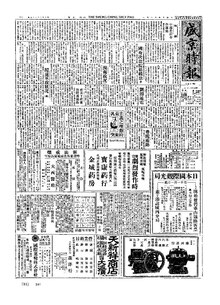The Sheng Ching Shih Pao (Chinese: 盛京時報) was a Japanese-owned Chinese newspaper established in Fengtian on October 18, 1906[1] by Japanese journalist named Nakajima Masao (中島真雄), after Japanese controlling of Manchuria as a result of Russo-Japanese War between 1904 and 1905. It ceased to operate at the end of Second Sino-Japanese War during the Surrender of Japan in August 1945. The newspaper received financial assistance from Japan's consulate-general in Fengtian during its early years.[2] Some modern writers, unaware of its official English title, translated to English from its Chinese name as Shengjing Times, Shengjing Shibao,[3] or abbreviated SJSB.[4]
 The issue number 306 with English title | |
| Type | Daily newspaper |
|---|---|
| Format | Broadsheet |
| Founder(s) | Nakajima Masao |
| Founded | October 18, 1906 |
| Political alignment | Pro-Japan |
| Language | Traditional Chinese |
| Ceased publication | 1945 |
| Headquarters | Fengtian |
| OCLC number | 648980257 |
| The Sheng Ching Shih Pao | |||||||||
|---|---|---|---|---|---|---|---|---|---|
| Traditional Chinese | 盛京時報 | ||||||||
| Simplified Chinese | 盛京时报 | ||||||||
| |||||||||
Its name Sheng Ching (盛京), a Mandarin Chinese name with meaning flourishing capital, once a capital of Manchu, then known as Mukden in English or Fungtien (奉天) prefecture, becomes present-day Shenyang. It reused this name from a Russian-owned newspaper, running from Russian invasion of Manchuria.[5]
The newspaper was the highest circulation Chinese language daily newspaper[6] and the most important instrument of Japanese press influence in Manchuria.[7] It is the first Chinese-language newspaper published by the Japanese in Northeast China,[8] and it was also Japan's longest-published newspaper in China.[9]
With a circulation comparable to that of Far Eastern Journal, its dominance of public opinion in the Northeast China remained unchallenged after the demise of Far Eastern Journal until the closing months of the World War II.[10]
References
edit- ^ David George Johnson; Andrew James Nathan; Evelyn Sakakida Rawski (1985). Popular Culture in Late Imperial China. University of California Press. pp. 362–. ISBN 978-0-520-06172-9.
- ^ Dissertation Abstracts International: The humanities and social sciences. A. University Microfilms. August 2009. pp. 657–.
- ^ Melissa S. Dale (1 November 2018). Inside the World of the Eunuch: A Social History of the Emperor's Servants in Qing China. Hong Kong University Press. pp. 206–. ISBN 978-988-8455-75-1.
- ^ Rana Mitter; University Lecturer in History and Politics of Modern China Rana Mitter (2 December 2000). The Manchurian Myth: Nationalism, Resistance, and Collaboration in Modern China. University of California Press. pp. 230–. ISBN 978-0-520-22111-6.
- ^ 平石, 淑子. "二十世紀初頭の中国東北地区における文学状況について――『盛京時報』を中心に――" (PDF). お茶の水女子大学中国文学会報 (第三十四号): 五, 十六.
- ^ Rajeswary Ampalavanar Brown; Justin Pierce (4 December 2013). Charities in the Non-Western World: The Development and Regulation of Indigenous and Islamic Charities. Routledge. pp. 127–. ISBN 978-1-317-93852-1.
- ^ Robert Cribb; Narangoa Li (27 August 2020). Imperial Japan and National Identities in Asia, 1895-1945. Taylor & Francis. pp. 120–. ISBN 978-1-00-014401-7.
- ^ The Dictionary of Modern Chinese History. History of Chinese Communist Party Publishing House. 1992. pp. 622-.
- ^ The "ZUI" of Chinese journalism. Xinhua Publishing House. 2005. pp. 92-. ISBN 978-7-5011-6950-4.
- ^ Dan Ben-Canaan; Frank Grüner; Ines Prodöhl (29 October 2013). Entangled Histories: The Transcultural Past of Northeast China. Springer Science & Business Media. pp. 110–. ISBN 978-3-319-02048-8.